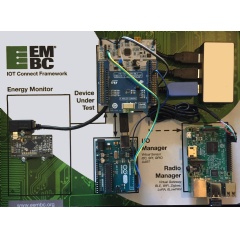EEMBC® Benchmark Reveals True Energy Cost of Using Bluetooth® LE for the Internet of Things
Industry-Standard Benchmark Evaluates Energy Efficiency of Microcontrollers and Radio Modules in IoT End Points
EEMBC®, the industry-consortium setting the real-world standards for valuable and practical application-specific benchmarks, today announced the availability of EEMBC IoTMark™-BLE, a benchmark and analysis tool that measures the energy efficiency of microcontrollers and Bluetooth radios used in IoT edge-node devices (end points) ¹.
Battery life is often a critical factor in the development of these end-node devices, especially when they are difficult or inconvenient to access. While many microcontrollers are already designed for ultra-low power, a big portion of the energy budget in an IoT application must be allocated for transmitting and receiving data. As a result, whether the radio function is integrated into the microcontroller or added as a separate module, its energy consumption is often the dominant factor and can vary considerably between competing devices.
“The IoTMark-BLE provides IoT system developers with the means to select optimal microcontroller and wireless solutions for their application by going beyond the limited datasheet specifications that tell only part of the story,” said Brent Wilson, co-chair of the EEMBC IoT-Connect working group and director of applications engineering at Silicon Laboratories. “IoTMark-BLE measures the energy used by the full subsystem including the MCU, the radio, and the protocol stack, while they perform relevant real-world tasks. Each part of the system impacts energy efficiency, so evaluating the whole radio system provides the most realistic evaluation of its battery life.”
The IoTMark-BLE is the first of a suite of benchmarks that the EEMBC IoT-Connect Working Group will deliver. Although the IoTMark-BLE targets IoT devices utilizing Bluetooth for communication, the benchmark runs on a flexible, IoT-Connect benchmark framework that EEMBC developed to accommodate additional benchmarks targeting other communication protocols, including Wi-Fi, 6LoWPAN, and LPWAN. The Consortium is working to produce a suite of benchmarks that allow comparisons between microcontrollers, radios, and modules as well as between competing communication protocols. The key components of this flexible IoT-Connect framework include 1) an EnergyMonitor to measure energy; 2) a radio manager, to coordinate the communication with the device under test (DUT); and 3) an IO Manager to synchronize activities and to simulate a sensor input on the DUT’s I2C or serial peripheral interface (SPI).
“Bluetooth Low Energy (BLE) is a popular technology for many IoT edge-node applications, such as health monitors, home automation devices, and wearable devices. Each application can vary a range of parameters including payload size, frequency of payload transmission, and transmit power. So EEMBC members had to agree on the specific set of tests and measurements to cover a wide cross section of these applications,” said Mark Wallis, co-chair of the EEMBC IoT working group and system architect at STMicroelectronics. “With IoTMark-BLE and the IoT-Connect framework, we’ve made it as easy as possible for developers to select the parameters and functions to ensure equitable comparisons while providing valuable insight beyond datasheet specifications ².”
“The IoT-Connect benchmark framework, which supports IoTMark-BLE, has the flexibility to accommodate various communication protocols, and is also sufficiently portable to work with any vendor’s microcontroller and radio-module products. We also designed the framework to work with our other present and future benchmarks, including IoT-Secure and ULPBench,” said Peter Torelli, EEMBC director of technology. ”As always, the EEMBC benchmarks make customers’ AND semiconductor manufacturers’ jobs easier by encouraging the use of industry-standard benchmark results to inform their decisions, rather than having to demystify unsubstantiated claims from competitors.”
All interested parties are welcome to join this working group to help define future profiles of this IoT benchmark, ensuring the maximum coverage and relevance for IoT communication protocols and end-user scenarios.
Current working group members include Ambiq Micro, Analog Devices, ARM, Cypress Semiconductor, Dialog Semiconductor, Flex, Imagination Technologies, Intel, Microchip, Nordic Semiconductor, NXP, Renesas, Silicon Labs, STMicroelectronics, Synopsys, and Texas Instruments. Contact EEMBC directly for more information; www.eembc.org.
# # #
About EEMBC
EEMBC was formed in 1997 to develop performance benchmarks for the hardware and software used in embedded systems. EEMBC benchmarks predict the performance and energy consumption of embedded processors and systems in a range of applications (e.g. autonomous driving, mobile imaging, Internet of Things, scale-out servers, and mobile devices) and disciplines (processor core functionality, floating-point, multicore, and energy consumption).
EEMBC members include Ambiq Micro, AMD, Analog Devices, Andes Technology, ARM, C-Sky Microsystems, Cavium, Codeplay Software, Cypress Semiconductor, Dell, Dialog Semiconductor, Flex Ltd., Green Hills Software, Huawei Technologies, IAR Systems, Imagination Technologies, Intel, Marvell Semiconductor, Microchip Technology, Nokia, Nordic Semiconductor, NVIDIA, NXP Semiconductors, Realtek Semiconductor, Renesas Electronics, Samsung Electronics, Silicon Labs, Somnium Technologies, Sony Interactive Entertainment, STMicroelectronics, Synopsys, Texas Instruments, and Wind River Systems.
EEMBC and CoreMark are registered trademarks of the Embedded Microprocessor Benchmark Consortium. All other trademarks appearing herein are the property of their respective owners.
¹ An edge node, which is the ’thing’ of the IoT, has four primary parts: 1) the sensors or transducers; 2) the processing (e.g. security, compression, protocol stack, data analysis); 3) the interfaces connecting the transducers and microcontroller; and 4) a communication mechanism used to transmit/receive information between the edge node and the network.
² STMicroelectronics is one of several vendors to include EEMBC benchmark results in its datasheets. For example, this STM32L431xx datasheet shows results for both EEMBC CoreMark and ULPBench.
( Press Release Image: https://photos.webwire.com/prmedia/57533/208489/208489-1.jpg )
WebWireID208489
- Contact Information
- Markus Levy
- President
- EEMBC
- (1) 5306729113
- markus.levy@eembc.org
This news content may be integrated into any legitimate news gathering and publishing effort. Linking is permitted.
News Release Distribution and Press Release Distribution Services Provided by WebWire.
